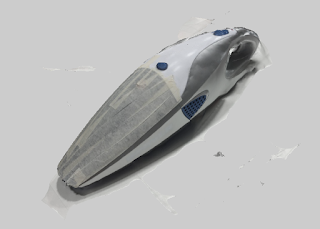In this attempt I tried to use another method to fabricate the other half of the skin. As my aim is to resemble a very obvious streamline feature of the handheld vacuum, I decided to use the shrinker after watching several youtube channels such as Lazze Metal Shaping. Firstly I drew the streamline on the metal sheet, and I used the shrinker to bend along the line. The result is quite good as the streamline really stands out, however my shrinker skill is not developed yet, so I have leaved some shrink marks on the skin along the streamline, which I need to get improved next time.
I spend around an hour on the shrinker, because I kept adjusting the fold line until the line fits the streamline of my template. An accurate fold line gives me a good foundation to work on. After this, I started working on the body of the skin, which was tough, especially when shaping the handle part of the skin, I spent 4 hours to hammer on the surface of the skin until it finally fits my template. The result is shown below.
Other than the shrink marks, this attempt is actually more precise and accurate than the second attempt. From the images above, you can really tell the skin fits better to the template, thanks to the shrinker, which makes the job easier, quicker and more accurate. However, I am still not satisfied with the result and I hope I can create a perfect fitting skin later in the course.


































